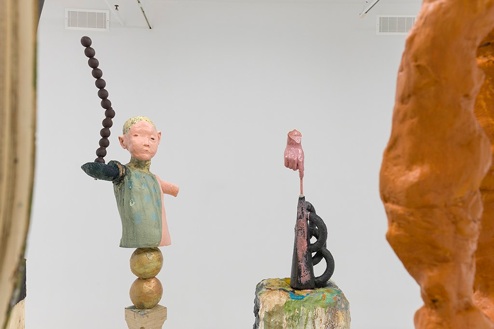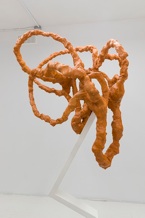Here is what we see. Eight assemblages of diverse forms, each contain something between raw and industrial material, fabricated and found objects, sinuous and angular lines and lyrical or geometric abstraction and figuration. In examining the entire installation, one recognizes the upper part of a body and the truncated arms of a child deposited on a roughly hewn plinth, sculpted in the round, like the feet of a solid piece of wooden furniture, the cast of a human foot mounted on a kind of totem or armour reminiscent of bull’s horns, a pair of hands evoking a grasping gesture and a Greco-Roman inspired column. Here ends any iconographic references to the real world that recall different cultures and eras (Greek, Classic, American, kitsch, etc.). The rest is in the order of abstraction, which nevertheless is able to lend an anthropomorphic character to each of the installation’s elements. The visitor remains excluded, condemned to circulate at the exterior and relegated to the status of a witness to eight strange busts, an assembly of statues or effigies of marginal people with odd, eclectic looks arranged in the room to form a circle or an arena. Are they acting in unison or, are they preparing some kind of rowdy confrontation? We are unable to respond; the situation appears suspended, open to interpretation.
With complete creative freedom, evident in the mix of styles and notably in the making of his work, we are perhaps allowed to associate it with artistic movements of days past, whose pertinence like surrealism or the more recent neo-expressionism and figurative movements cannot be eliminated. It is these more recent tendencies, followed by the rigorous methodologies of formalist and conceptual artists that permits a re-introduction of the figurative and with it, a postmodern concept of Art History in the 1980’s.
Art forms will not develop further in an ascending movement motivated by the idea of progress and perfection — an idealist concept about artistic destiny — rather, searching everywhere, artists draw from all kinds of sources without differentiating cultural and historical references hierarchically.
Proof is within the work: Dans le creux de l’idolâtrie (In pit of Idolatry) forms are reduced to the most purified elements associated with the minimalist movement and the cultural elite, rubbing elbows with rougher, unfinished forms that refer to the so-called mass or popular culture. Various skills come together: from the folk-art, wood carver to the artist forming clay or polyurethane figures, all the while using various industrial techniques for working with wood and steel. The sculptural objects for the most part are covered with layers of paint; thus blurring the specificity of the materials and presenting this very graphic installation like an infinite number of paintings: a colorful composition made visible from a multitude of angles by its very tridimensional nature. Many elements intentionally left in place give a raw, unfinished look to the entire installation, indicating that the artist is not seeking perfection, but wishes rather to affirm incompleteness as an aesthetic principle.
Here, Morest blurs genres, horizons, restraints and apprehensions. Multiple references coexist in the same space and lend support to the
artistic forms he has created, in the sense that the work speaks for itself, that the form contains the essence of its meaning: a rare quality in present times when concept often seems to prevail over form. So unsparing of contents, there is no need of explanatory texts in order to understand the breadth of Morest’s work. To form our own opinion, we must see the work; it must be observed.
A text by Ève Dorais
Translated from french by Karen Trask
Originally from the Outaouais area, Gabriel Morest moved to Montreal to study at Université du Quebéc à Montréal, completing his BFA in 2010. There, he earned the McAbbie award for painting and a Jury’s mention for the Albert Dumouchel award. And he took advantage of an inter-university program to complete a semester at the School of Decorative Arts in Strasbourg in 2009. Since 2010, he has participated in numerous group exhibitions in Montreal (CLARK, Arprim, CIRCA), in Rouyn-Noranda (l’Écart) and in France (Sarcelle). In 2011, his work was presented in a solo exhibition at Maison de la culture de Gatineau. And in 2015, solo exhibitions will be held at the artist-run centres CIRCA art actuel, Montreal and l’Œil de poisson, Quebec City, and at Centre d’exposition L’imagier, Gatineau. He has received support for his projects from the Conseil des arts et des lettres du Québec. A multi-disciplinary artist, his work focuses on issues concerning society, the perception of its history, its icons, violence, joys and also its setbacks and advances.
Ève Dorais has made her way in the art milieu as a curator, author, artist and coordinator of exhibitions and publications. She studied visual arts and art history at Université du Quebéc à Montréal. As an artist, she has presented her work at DARE-DARE, at Caravanserail and at Centre des arts actuels Skol. In 2014, she curated Ras le bol, which included a significant performance program that was presented at Skol and at the second edition of Project HoMa. She was co-curator for ORANGE 2012, Les Mangeurs, l’événement d’art actuel de Saint-Hyacinthe and in 2007, co-curator with Aude Moreau for 11 : 1/1, presented at CDEx in collaboration with Articule. Her articles have been published in Spirale, esse art + opinions, Inter, Etc Montréal and she has also written essays for several exhibition pamphlets and catalogues.














